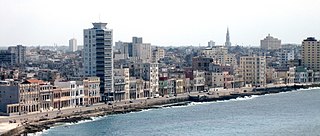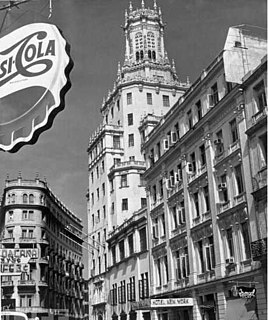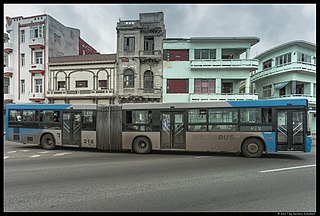
Havana is the capital city, largest city, province, major port, and leading commercial center of Cuba. The city has a population of 2.1 million inhabitants, and it spans a total of 781.58 km2 (301.77 sq mi) – making it the largest city by area, the most populous city, and the fourth largest metropolitan area in the Caribbean region.

Maria Teresa is the spouse of Grand Duke Henri, who acceded to the throne in 2000. She was born in Cuba.

Hotel Tryp Habana Libre is one of the larger hotels in Cuba, situated in Vedado, Havana. The hotel has 572 rooms in a 25-floor tower at Calle 23 and Calle L.

Vedado is a central business district and urban neighborhood in the city of Havana, Cuba. Bordered on the east by Calzada de Infanta and Central Havana, and on the west by the Alemendares River and Miramar / Playa district, Vedado is a more modern part of the city than the areas to the east, developed in the first half of the 20th century, during the Republic period. In 2016 it was described by one commentator as the city's "most affluent" section. The main street running east to west is Calle 23, also known as "La Rampa". The northern edge of the district is the waterfront seawall known as the Malecón, a famous and popular place for social gatherings in the city. The area popularly referred to as 'Vedado' consists of the wards of Vedado, Rampa, Vedado-Malecón and Carmelo, all in the municipality of Plaza de la Revolución.

Plaza de la Revolución, "Revolution Square", is a municipality and a square in Havana, Cuba.

El Cementerio de Cristóbal Colón, also called La Necrópolis de Cristóbal Colón, was founded in 1876 in the Vedado neighbourhood of Havana, Cuba to replace the Espada Cemetery in the Barrio de San Lázaro. Named for Christopher Columbus, the cemetery is noted for its many elaborately sculpted memorials. It is estimated the cemetery has more than 500 major mausoleums. Before the Espada Cemetery and the Colon Cemetery were built, interments took place in crypts at the various churches throughout Havana, for example, at the Havana Cathedral or the Iglesia del Espíritu Santo in Havana Vieja.

The Malecón is a broad esplanade, roadway, and seawall that stretches for 8 km along the coast in Havana, Cuba, from the mouth of Havana Harbor in Old Havana, along the north side of the Centro Habana neighborhood and the Vedado neighborhood, ending at the mouth of the Almendares River. New businesses are appearing on the esplanade due to economic reforms in Cuba that now allow Cubans to own private businesses.

The Amadeo Roldán Theatre is a theatre in Havana, Cuba built in 1929. The theatre was destroyed in 1977 by a pyromaniac; it was re-opened in 1999 as the head office of the National Symphony Orchestra of Cuba which performs seasonal every Sunday at 11:00PM.
The Museum of Decorative Arts, at 17th and E streets in the Vedado district of Havana, Cuba is a decorative arts museum in the former residence of the María Luisa Gómez-Mena viuda de Cagiga, Countess of Revilla de Camargo, sister of José Gómez-Mena Vila, the owner of the Manzana de Gómez. It was designed in Paris by architects P. Virad and M. Destuque, inspired in French Renaissance and was built between 1924 and 1927 in a neo-classical style.

Leonardo Morales y Pedroso was a prominent Cuban architect in Havana in the early 20th century.
Nelson Ponce Sanchez was born in 1975, in Alamar. He is an illustrator and graphic designer, especially known for his Vampiros en La Habana poster, as well as his active participation in the Camaleón collective.
Juan Carlos Cremata Malberti is a Cuban film director. He started his career as an author and actor for children's TV shows made for the Cuban Institute of Radio and Television from 1981 to 1987. He is known for directing the movie Viva Cuba, which received the Best Children's Film award at the Cannes International Film Festival in 2005.

The FOCSA Building was built from 1954 to 1956, and named after the contracting company Fomento de Obras y Construcciones, Sociedad Anónima; it is 121 metres tall and located in the Vedado section of Havana. The architects were Ernesto Gómez Sampera (1921–2004), Mercedes Diaz, and Martín Domínguez Esteban (1897-1970) who was the architect of the Radiocentro CMQ Building. The structural engineer was Luis Sáenz Duplace, of the firm Sáenz, Cancio & Martín, and professor of engineering at the University of Havana. The civil engineers were Bartolome Bestard and Manuel Padron. Gustavo Becquer and Fernando H.Meneses were the mechanical and electrical engineers respectively.

Paseo del Prado, is a promenade in Havana, Cuba near the old city wall, and the division between Centro Habana and Old Havana. Technically, the Paseo del Prado includes the entire length of Paseo Martí approximately from the Malecon to Calle Máximo Gómez, the Fuente de la India fountain. The promenade has had several names, it was renamed Paseo de Martí in 1898 with the island's independence from Spain. Despite the historic references, the people of Havan simply call it "El Prado."

The Havana MetroBus, shortened as MB, is a public bus network serving the city of Havana, capital of Cuba. It is the principal public transport network of Cuban capital and is conceived as a surface subway.
Alicia Leal Veloz ]] is a Cuban painter. She was born in Sancti Spíritus, Cuba.

The Palace of the Revolution, is a palace in Havana, Cuba within the Plaza de la Revolución that serves as the house of the Cuban government.

The Radiocentro CMQ Building complex consisted of a radio and television production facility and office building in Calle L and La Rampa in El Vedado, Cuba, and it was modeled after Raymond Hood's 1933 Rockefeller Center in New York City. With 1,650 seats, the theater first opened on December 23, 1947 under the name Teatro Warner Radiocentro, it was owned by brothers Goar and Abel Mestre. Today the building serves as the headquarters of Cuban Institute of Radio and Television (ICRT).

Architecture of Cuba refers to the buildings, structures and architectural history throughout the Caribbean island nation of Cuba. The unique mix of cultural and artistic influences throughout history have led to Cuba being renowned for its eclectic and diverse architecture, which can be defined as a unique fusion of numerous well-studied architectural styles from around the world.















